Take Two Pain Killers and Call Me Again in the Morning Nancy Drew Sha
Dr. Evan Cohn studied radiology at the University of Virginia Health System. Years later, his life was saved by the UVA radiologists that helped train him. Acquire more about Dr. Cohn's SAH experience and recovery, and read the comments to hear about other people'south SAH journeys. You tin can share your experience past scrolling to the very bottom of the page and entering your comment in the annotate box.
An Update from Dr. Cohn, 9/1/21: Scroll to the lesser of the article to read about how Dr. Cohn is doing nearly six years after his subarachnoid hemorrhage.
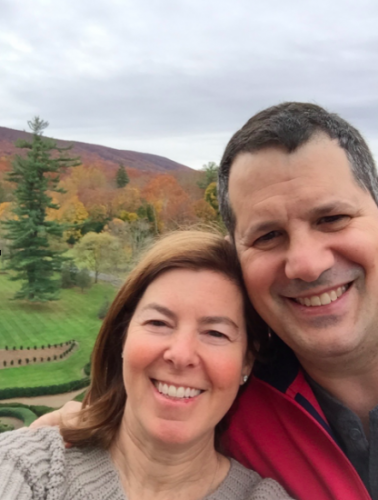
Dr. Evan Cohn and his married woman Amy at The Homestead Resort
In Oct 2015, Evan Cohn and his married woman Amy were on vacation at The Homestead Resort in Hot Springs, VA. They took a selfie showing wide smiles and a cute Virginia landscape in the background.
One hour later, Dr. Cohn began suffering from a severe headache, nausea, and sweating. Within 15 minutes of these symptoms, he was on his way to the Bath County Emergency Room.
A CT of the head showed a subarachnoid hemorrhage (bleeding between the two membranes that environment the encephalon), and staff immediately prepared him for a helicopter ride to UVA Health'due south main infirmary in Charlottesville.
An Incredible Series of Events
Every bit a physician, Dr. Cohn knew his condition was serious. From 1993-1998, he had studied at UVA Radiology and Medical Imaging, completing his residency and musculoskeletal fellowship. When he finished the program, he began work at the Presbyterian Hospital of Dallas in Dallas, Texas.
The series of events was incredible. Dr. Cohn happened to be vacationing in Virginia and was sent to the very hospital where he had studied to become a radiologist. He notwithstanding knew other radiologists who worked there. On his was to UVA, he texted Dr. Mark Anderson, one UVA radiologist he knew from his residency days.
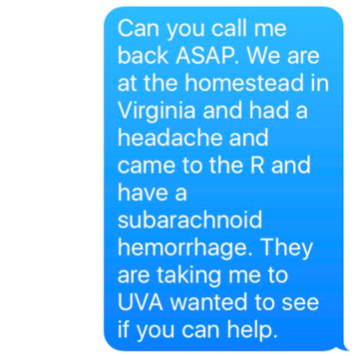
Dr. Cohn'southward text to Dr. Mark Anderson, radiologist at UVA

UVA Health's Pegasus helicopter
Dr. Anderson called and told him that Dr. Lee Jensen and Dr. Avery Evans, both neurointerventional radiologists, were at the hospital and were ready for him. "It was a comfort to me to know I was going to UVA and that I was in very good easily," said Dr. Cohn. "Dr. Jensen and Dr. Evans were both there when I was a resident and they are excellent physicians."
Afterwards this, he remembers a nurse asking to pray with him then waiting for the helicopter to accept off, wondering if he would ever see his family unit again. After that, his retentivity is bare. He doesn't call back the two weeks he spent at the UVA Hospital, the anxiety that his wife and daughters endured, or the doctors and nurses who cared for him during his stay.
Recovery and a New Normal
The time following his release from the hospital was hard. In Nov of 2015, a calendar month after the hemorrhage, he started attending a yr-long rehabilitation plan for six.v hours a day. He supplemented the rehab with his own efforts to relearn Spanish and by playing games like Rummikub as well as brain games on his telephone and computer.
Today, Dr. Cohn says he has a new normal. He gets fatigued hands and doesn't call back details well. He still gets desultory headaches. He'southward had to adjust his life habits. But since the beginning, his family has surrounded him with incredible support and love.
While Dr. Cohn has always been a positive person with a positive outlook on life, this life-changing event strengthened this trait of his. "I'm lucky to exist alive," he said. "I found out later that 50% of people with the aforementioned diagnosis don't go far." The hemorrhage made him realize that he doesn't know the finish of his story–no one does. "You don't know what'southward going to happen on any given day, and you should bask every day to the fullest," he said. "Now, every night I become through what I am satisfied with, what I've enjoyed, what I'yard thankful for, and what I am hopeful for that 24-hour interval."
To those who have experienced a subarachnoid hemorrhage, Dr. Cohn encourages them: "What yous're going through is normal. Recovery is long and hard. Almost importantly, it's individual."
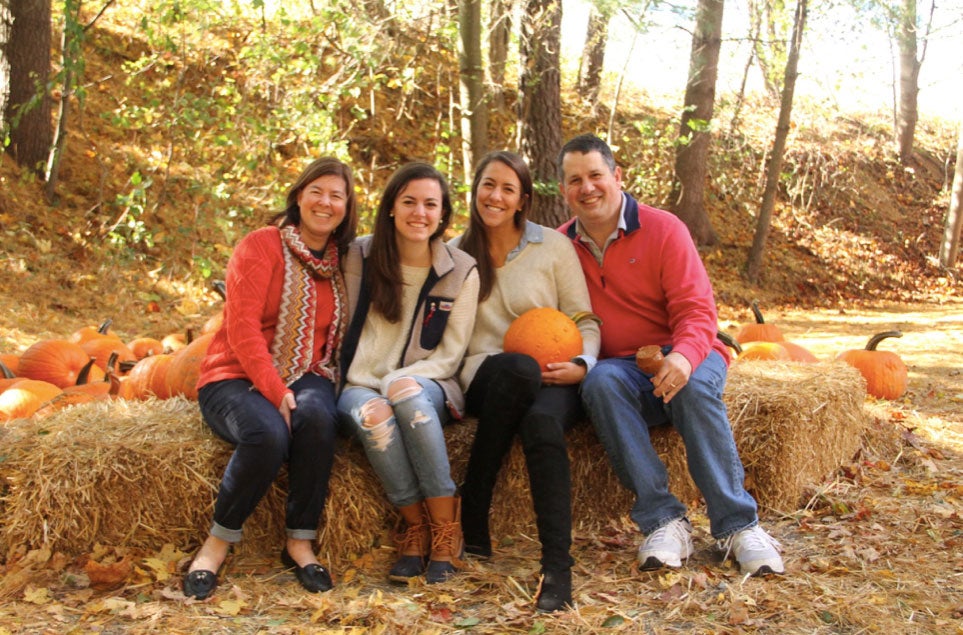
Dr. Cohn kept going dorsum to his family and how incredible they are. "It's been a definite change for everybody," he said. "I appreciate my family and am so thankful for them. Amy, his wife, chimed in and said, "It's a good lesson to love your family and appreciate them while they're here." Dr. Cohn agreed, "I feel grateful everyday. I have realized the preciousness of life."
September 2021: An Update from Dr. Evan Cohn
Evan Cohn spoke with usa in the summertime of 2022 to requite the states an update near his life six years after a subarachnoid hemorrhage. He's pleased that his original commodity has resonated with so many people. "My hope is that sharing what I went through and what has helped me tin can help others," he says. "And I'yard very glad that the comment section has been a identify for people to connect and see that they are not lone."
Evan Cohn's life looks very dissimilar than it did six years agone. Staying healthy, functional and nowadays requires daily, ongoing effort from him and his family. That starts with simple things, similar getting enough remainder every night, or writing everything down–appointments, tasks, lists–to help him call back to do them.
Dr. Cohn had to go out his medical practice every bit a radiologist because of connected fatigue and cognitive bug afterwards his subarachnoid hemorrhage. Physicians are instructed to 'Do No Damage,' and he knew that mistakes he would make in his work interpreting medical images could be deadly for his patients.
Only not being released to go back to work equally a medico was more than impactful than just giving up a job: it meant letting go of his identity as a md. That required a broader acceptance of what his life is at present, versus what he imagined for himself earlier his hemorrhage.
And but as letting go of his identity equally a physician was difficult, so too was accepting a new identity as a survivor. He struggles with knowing exactly how to talk about it and share without overdoing it.
Making Changes to Brand Life Work
Today, Evan continues to experience fatigue, headaches, memory and concentration issues, and sleep disturbances. He can no longer multi-chore and has to focus on one thing at a time.
Because it takes him longer to process chat than virtually people, he has a hard time participating in groups. If he goes out to dinner with friends, for example, he and his wife, Amy, take worked out a system where she pauses earlier answering a question addressed to both of them. That gives Evan time to answer if he wants to; otherwise, he wouldn't be able to answer quickly enough.
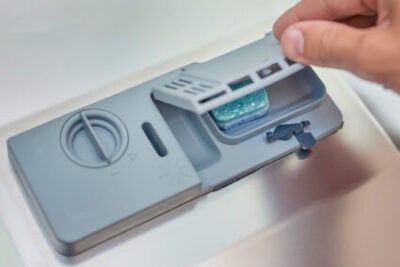
When it comes to tasks and chores, he has developed rituals to help him call back to complete them. For example, if he empties the dishwasher, he immediately puts soap in information technology when it's empty. Otherwise, he would forget and run it afterwards without putting in the soap.
He has similar ways of reminding himself to have his medication or remember appointments. For anything related to an appointment or a task that must be done at a specific time, he adds them to his telephone agenda with an warning to make sure he doesn't forget.
No matter what happens in a day, Evan tries to keep his challenges and mistakes in perspective. "A patient in rehab with me used to ask herself the question 'Are my mistakes deadly? Are they fatal?'" he reflects. "If the answer is no, and then while you don't like making them, yous need to go on it in perspective."
The Challenge of Invisible Disease
"So many people struggle with invisible diseases and weather condition," Dr. Cohn points out. "A person who has a broken leg is like shooting fish in a barrel to see. But psychiatric diseases, cancer, brain injuries – in those cases, you don't know what people are going through. Their struggles might not exit a visible mark."
The invisibility of what Dr. Cohn experiences is an extra challenge. "I may wait normal," he says, "but y'all don't see the amount of work that it takes me to wait that manner."
Friends and acquaintances are well-intentioned and have been a tremendous source of support and comfort over the by vi years. Just sometimes they don't sympathize what is helpful for someone in Dr. Cohn's shoes to hear.
"Equally a brain injury survivor, nosotros don't want to hear 'We all forget things,'" he says. "It makes you have to recollect all the worst mistakes you've made. This isn't normal aging. I hear them wanting to connect, just it's not the same affair."
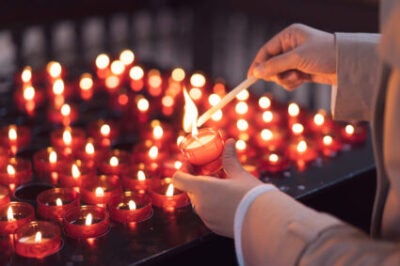
Instead, he finds simple gestures, like calculation him to prayer lists, lighting a candle, or offering thoughts and prayers, most impactful. "I used to recall those things were kind of cheesy, but at present I feel they are very nice things to say," he says. "Especially when I know that the person really means it."
People agreement his limitations and mistakes makes a huge difference, equally is knowing that people are glad to take him around and don't need him to be perfect. If someone wants to assistance, he has found more than specific and straight questions most helpful. "'I'm coming over, what nighttime can I bring you dinner?' is a more helpful question than 'Let me know how I can help'" he says.
How Are You Doing Today?
A quote from Facebook CFO Sheryl Sandberg has stuck in Evan's mind in the years since his hemorrhage. Afterward the sudden death of her married man in 2015, Sheryl institute the standard question people would ask, "How are yous?", to be hard to answer. She knows they meant well. But saying good or fine felt similar a prevarication: after all, she was grieving a tremendous loss.
In her volume, Selection B, she suggests irresolute the question slightly, to "How are you doing today?" She sees this as a way to acknowledge the challenges that someone is facing. But it also acknowledges that they are getting through those challenges, day by solar day. And it reminds them to take things i day at a time. That has been immensely helpful for Dr. Cohn.
The Honey of Family unit

In a higher place all, Dr. Cohn attributes his connected well-being to the dear, support and understanding of his family – his wife and his daughters.
"My daughters have become much more than patient and agreement of me," he says. "They know that my retention isn't what it used to be and that I have cognitive deficits."
"My wife has been incredible," he says. "She'south patient, working together with me to understand and non pointing out my mistakes all the time. She'southward and so agreement and supportive."
Evan could encounter a spouse in her shoes being frustrated with him for needing extra help and making mistakes. Simply that's not how Amy feels. "The fashion I see information technology, I am lucky to have him here, adjacent to me," she says.
Dr. Cohn echoes that sentiment. His final takeaway for anyone is his shoes, or anyone with a family member who experienced what he did, is simple.
"Live life to the fullest."
Source: https://med.virginia.edu/radiology/2021/09/01/living-well-after-surviving-a-subarachnoid-hemorrhage/
0 Response to "Take Two Pain Killers and Call Me Again in the Morning Nancy Drew Sha"
Post a Comment